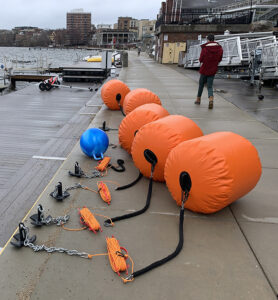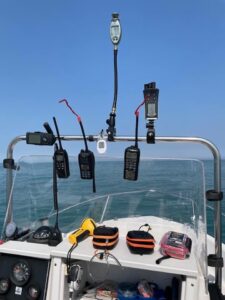Successful Race Management Requires the Right Equipment
Delivering a quality experience for your sailors requires appropriate attention to lots of details. In addition to making sure your plans align with the desires and culture of your competitors, regatta organizers need to provide appropriately skilled race management personnel AND the right equipment for the Race Committee team to conduct races properly. Waiting until the morning of the event to gather and prepare equipment is a bad idea. The following are just a few of the key ingredients required:
- A Signal Boat with a reliable motor and appropriately sized anchor. The Signal Boat anchor line should be at least 5X the deepest point in your race area.
- The required methods for communicating with the competitors including signal flags, signal boards and automated sound devices for starting sequences. Flags need to be large enough for all competitors to see them. Sound devices need to be loud enough for all competitors to hear.

- Course race marks of appropriate size, shape and color with appropriately sized anchors and long enough lines for every mark. Mark anchor lines should at least 1.5-2X the deepest location in your race area. Don’t forget to have a reliable way to properly inflate the marks.
 VHF radios so the race management team can communicate with each other, the shore, and any safety personnel.
VHF radios so the race management team can communicate with each other, the shore, and any safety personnel.- Reliable wind instruments to determine wind speed and direction.
- An appropriate number of reliable markset boats with at least one experienced operator and an agile assistant. Mark sets should have wind instruments, signal flags and sound devices. Don’t forget proper safety equipment such as a VHF radio, flotation devices, tow lines, etc. Click HERE to learn more about mark set boat information and training.
- If necessary, reliable and highly maneuverable umpire boats. Like markset and safety boats, these boats should be equipped with proper safety equipment such as a VHF radio, flotation devices, tow lines, etc.
- An appropriate number of reliable safety boats with skilled/trained operators and proper safety equipment such as a VHF radio, flotation devices, tow lines, etc. Click HERE to learn more about safety boat and training.
- An easily updatable Notice Board in a location easily found and seen by the competitors.
- Scoresheets, Protest Hearing forms and other necessary paperwork.
- A quiet room or location in which the Judges can conduct hearings.
- If required, reliable computer equipment and internet service to conduct registration, access online scoring programs, and communicate with competitors via web, email or text.
- Everything necessary (oftentimes a computer, internet access and a printer) to accurately and efficiently register all the competitors when they arrive at the beginning of the event.
If you or your organization host regattas on a regular basis, your competitors expect and assume that you own or can provide the proper equipment to conduct races.
As with any customer-focused endeavor, this requires that you (the provider of a service) make an appropriate investment in or have a way to provide everything necessary to give your customers a quality “product” or “experience” on the water.
Do NOT assume that your race official(s) can or will provide all this equipment!
Your race officials have already made a significant investment in their own training and, at best, own a few key “personal” pieces of equipment they prefer to use while running races.
For those who rarely or infrequently host events, we and a very select few of our peers own and travel with nearly all the equipment above and much more.
As illustrated in this photo, our “kit” also includes many duplicate and/or back-up items and devices. Click HERE to view a complete inventory of our personal race management equipment. Please feel free to use our list as a reference when evaluating the equipment you already have or that you need to invest in to properly serve your customers.
On those occasions when a key piece of equipment is forgotten or fails (and a back-up is not available), some creative problem-solving can be helpful, as illustrated in the photo below.




